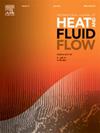Experimental investigations of flow boiling heat transfer performance in finned micro-channels
IF 2.6
3区 工程技术
Q2 ENGINEERING, MECHANICAL
International Journal of Heat and Fluid Flow
Pub Date : 2024-10-17
DOI:10.1016/j.ijheatfluidflow.2024.109610
引用次数: 0
Abstract
The flow boiling heat transfer and pressure drop in rectangular-finned micro-channels (i.e. micro-channel with rectangular fins) were experimentally investigated at five different fin-heights. At three different mass fluxes and a range of heat fluxes, heat transfer coefficients and pressure drops in the micro-channels were measured. The flow patterns during the flow boiling process were visualized to estimate the flow regime transitions in the micro-channels. The experimental results showed that the micro-channel with 500 μm height fins (i.e. tip clearance = 100 μm) performs the highest heat transfer and shows the highest resistance to flow boiling instability among the studied cases. Compared to the smooth micro-channel, the averaged heat transfer coefficient in the micro-channel with 500 μm height fins has been improved by up to 133.9 % at the same wall temperature. Compared to the micro-channel with 600 μm height fins (i.e. tip clearance = 0 μm), the averaged heat transfer coefficient in the micro-channel with 500 μm height fins has been improved by up to 45.8 %. At the initial point of flow instability, the micro-channel with 500 μm height fins has the highest pressure drop fluctuation frequency, the highest surface wetting frequency, and the lowest pressure drop variation coefficient among the studied cases. However, the micro-channel with 600 μm height fins has the lowest pressure drop fluctuation frequency and highest pressure drop variation coefficient, hence experiencing the longest dry-out process among the studied cases.
翅片微通道中流动沸腾传热性能的实验研究
实验研究了矩形翅片微通道(即带有矩形翅片的微通道)中五种不同翅片高度下的流动沸腾传热和压力降。在三种不同的质量通量和一系列热通量下,测量了微通道中的传热系数和压降。对流动沸腾过程中的流动模式进行了可视化,以估计微通道中的流态转换。实验结果表明,在所研究的情况中,带有 500 μm 高翅片(即顶端间隙 = 100 μm)的微通道传热效果最好,对流动沸腾不稳定性的抵抗力也最强。与光滑的微通道相比,在相同的壁温条件下,带有 500 μm 高翅片的微通道的平均传热系数提高了 133.9%。与采用 600 μm 高翅片的微通道(即顶端间隙 = 0 μm)相比,采用 500 μm 高翅片的微通道的平均传热系数最多提高了 45.8%。在流动不稳定的初始点,采用 500 μm 高翅片的微通道的压降波动频率最高,表面润湿频率最高,压降变化系数最低。然而,采用 600 μm 高度鳍片的微通道的压降波动频率最低,压降变化系数最高,因此在所研究的情况中经历的干燥过程最长。
本文章由计算机程序翻译,如有差异,请以英文原文为准。
求助全文
约1分钟内获得全文
求助全文
来源期刊

International Journal of Heat and Fluid Flow
工程技术-工程:机械
CiteScore
5.00
自引率
7.70%
发文量
131
审稿时长
33 days
期刊介绍:
The International Journal of Heat and Fluid Flow welcomes high-quality original contributions on experimental, computational, and physical aspects of convective heat transfer and fluid dynamics relevant to engineering or the environment, including multiphase and microscale flows.
Papers reporting the application of these disciplines to design and development, with emphasis on new technological fields, are also welcomed. Some of these new fields include microscale electronic and mechanical systems; medical and biological systems; and thermal and flow control in both the internal and external environment.
 求助内容:
求助内容: 应助结果提醒方式:
应助结果提醒方式:


